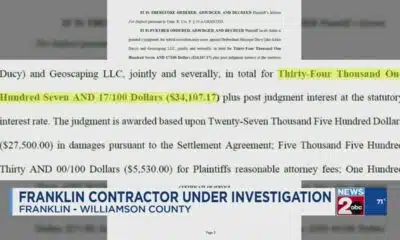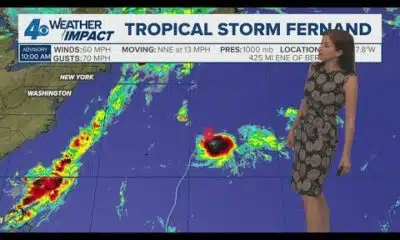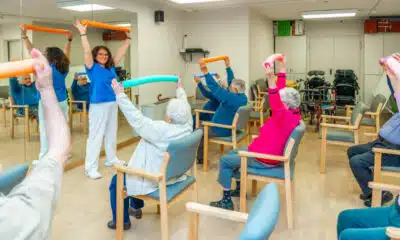News from the South - Louisiana News Feed
Pharmacists stockpile most common drugs on chance of targeted Trump tariffs
by Jackie Fortiér, KFF Health News and Arthur Allen, KFF Health News, Louisiana Illuminator
May 17, 2025
In the dim basement of a Salt Lake City pharmacy, hundreds of amber-colored plastic pill bottles sit stacked in rows, one man’s defensive wall in a tariff war.
Independent pharmacist Benjamin Jolley and his colleagues worry that the tariffs, aimed at bringing drug production to the United States, could instead drive companies out of business while raising prices and creating more of the drug shortages that have plagued American patients for several years.
Jolley bought six months’ worth of the most expensive large bottles, hoping to shield his business from the 10% across-the-board tariffs on imported goods that President Donald Trump announced April 2. Now with threats of additional tariffs targeting pharmaceuticals, Jolley worries that costs will soar for the medications that will fill those bottles.
In principle, Jolley said, using tariffs to push manufacturing from China and India to the U.S. makes sense. In the event of war, China could quickly stop all exports to the United States.
“I understand the rationale for tariffs. I’m not sure that we’re gonna do it the right way,” Jolley said. “And I am definitely sure that it’s going to raise the price that I pay my suppliers.”
GET THE MORNING HEADLINES.
Squeezed by insurers and middlemen, independent pharmacists such as Jolley find themselves on the front lines of a tariff storm. Nearly everyone down the line — drugmakers, pharmacies, wholesalers, and middlemen — opposes most tariffs.
Slashing drug imports could trigger widespread shortages, experts said, because of America’s dependence on Chinese- and Indian-made chemical ingredients, which form the critical building blocks of many medicines. Industry officials caution that steep tariffs on raw materials and finished pharmaceuticals could make drugs more expensive.
“Big ships don’t change course overnight,” said Robin Feldman, a UC Law San Francisco professor who writes about prescription drug issues. “Even if companies pledge to bring manufacturing home, it will take time to get them up and running. The key will be to avoid damage to industry and pain to consumers in the process.”
Trump on April 8 said he would soon announce “a major tariff on pharmaceuticals,” which have been largely tariff-free in the U.S. for 30 years.
“When they hear that, they will leave China,” he said. The U.S. imported $213 billion worth of medicines in 2024 — from China but also India, Europe, and other areas.
Trump’s statement sent drugmakers scrambling to figure out whether he was serious, and whether some tariffs would be levied more narrowly, since many parts of the U.S. drug supply chain are fragile, drug shortages are common, and upheaval at the FDA leaves questions about whether its staffing is adequate to inspect factories, where quality problems can lead to supply chain crises.
Private equity snaps up disability services, challenging state regulators
On May 12, Trump signed an executive order asking drugmakers to bring down the prices Americans pay for prescriptions, to put them in line with prices in other countries.
Meanwhile, pharmacists predict even the 10% tariffs Trump has demanded will hurt: Jolley said a potential increase of up to 30 cents a vial is not a king’s ransom, but it adds up when you’re a small pharmacy that fills 50,000 prescriptions a year.
“The one word that I would say right now to describe tariffs is ‘uncertainty,’” said Scott Pace, a pharmacist and owner of Kavanaugh Pharmacy in Little Rock, Arkansas.
To weather price fluctuations, Pace stocked up on the drugs his pharmacy dispenses most.
“I’ve identified the top 200 generics in my store, and I have basically put 90 days’ worth of those on the shelf just as a starting point,” he said. “Those are the diabetes drugs, the blood pressure medicines, the antibiotics — those things that I know folks will be sicker without.”
Pace said tariffs could be the death knell for the many independent pharmacies that exist on “razor-thin margins” — unless reimbursements rise to keep up with higher costs.
Unlike other retailers, pharmacies can’t pass along such costs to patients. Their payments are set by health insurers and pharmacy benefit managers largely owned by insurance conglomerates, who act as middlemen between drug manufacturers and purchasers.
Neal Smoller, who employs 15 people at his Village Apothecary in Woodstock, New York, is not optimistic.
“It’s not like they’re gonna go back and say, well, here’s your 10% bump because of the 10% tariff,” he said. “Costs are gonna go up and then the sluggish responses from the PBMs — they’re going to lead us to lose more money at a faster rate than we already are.”
Smoller, who said he has built a niche selling vitamins and supplements, fears that FDA firings will mean fewer federal inspections and safety checks.
“I worry that our pharmaceutical industry becomes like our supplement industry, where it’s the wild West,” he said.
Narrowly focused tariffs might work in some cases, said Marta Wosińska, a senior fellow at the Brookings Institution’s Center on Health Policy. For example, while drug manufacturing plants can cost $1 billion and take three to five years to set up, it would be relatively cheap to build a syringe factory — a business American manufacturers abandoned during the covid-19 pandemic because China was dumping its products here, Wosińska said.
It’s not surprising that giants such as Novartis and Eli Lilly have promised Trump they’ll invest billions in U.S. plants, she said, since much of their final drug product is made here or in Europe, where governments negotiate drug prices. The industry is using Trump’s tariff saber-rattling as leverage; in an April 11 letter, 32 drug companies demanded European governments pay them more or face an exodus to the United States.
Brandon Daniels, CEO of supply chain company Exiger, is bullish on tariffs. He thinks they could help bring some chemical manufacturing back to the U.S., which, when coupled with increased use of automation, would reduce the labor advantages of China and India.
“You’ve got real estate in North Texas that’s cheaper than real estate in Shenzhen,” he said at an economic conference April 25 in Washington, referring to a major Chinese chemical manufacturing center.
Despite historic indictment, doctors will keep mailing abortion pills across state lines
But Wosińska said no amount of tariffs will compel makers of generic drugs, responsible for 90% of U.S. prescriptions, to build new factories in the U.S. Payment structures and competition would make it economic suicide, she said.
Several U.S. generics firms have declared bankruptcy or closed U.S. factories over the past decade, said John Murphy, CEO of the Association for Accessible Medicines, the generics trade group. Reversing that trend won’t be easy and tariffs won’t do it, he said.
“There’s not a magic level of tariffs that magically incentivizes them to come into the U.S.,” he said. “There is no room to make a billion-dollar investment in a domestic facility if you’re going to lose money on every dose you sell in the U.S. market.”
His group has tried to explain these complexities to Trump officials, and hopes word is getting through. “We’re not PhRMA,” Murphy said, referring to the powerful trade group primarily representing makers of brand-name drugs. “I don’t have the resources to go to Mar-a-Lago to talk to the president myself.”
Many of the active ingredients in American drugs are imported. Fresenius Kabi, a German company with facilities in eight U.S. states to produce or distribute sterile injectables — vital hospital drugs for cancer and other conditions — complained in a letter to U.S. Trade Representative Jamieson Greer that tariffs on these raw materials could paradoxically lead some companies to move finished product manufacturing overseas.
Fresenius Kabi also makes biosimilars, the generic forms of expensive biologic drugs such as Humira and Stelara. The United States is typically the last developed country where biosimilars appear on the market because of patent laws.
Louisiana considers ‘homelessness courts’ as housing advocates stress lack of resources
Tariffs on biosimilars coming from overseas — where Fresenius makes such drugs — would further incentivize U.S. use of more expensive brand-name biologics, the March 11 letter said. Biosimilars, which can cost a tenth of the original drug’s price, launch on average 3-4 years later in the U.S. than in Canada or Europe.
In addition to getting cheaper knockoff drugs faster, European countries also pay far less than the United States for brand-name products. Paradoxically, Murphy said, those same countries pay more for generics.
European governments tend to establish more stable contracts with makers of generics, while in the United States, “rabid competition” drives down prices to the point at which a manufacturer “maybe scrimps on product quality,” said John Barkett, a White House Domestic Policy Council member in the Biden administration.
As a result, Wosińska said, “without exemptions or other measures put in place, I really worry about tariffs causing drug shortages.”
Smoller, the New York pharmacist, doesn’t see any upside to tariffs.
“How do I solve the problem of caring for my community,” he said, “but not being subject to the emotional roller coaster that is dispensing hundreds of prescriptions a day and watching every single one of them be a loss or 12 cents profit?”
YOU MAKE OUR WORK POSSIBLE.
This article first appeared on KFF Health News and is republished here under a Creative Commons license. KFF Health News is a national newsroom that produces in-depth journalism about health issues and is one of the core operating programs at KFF—an independent source of health policy research, polling, and journalism. Learn more about KFF and subscribe to KFF Health News’ free Morning Briefing.
Louisiana Illuminator is part of States Newsroom, a nonprofit news network supported by grants and a coalition of donors as a 501c(3) public charity. Louisiana Illuminator maintains editorial independence. Contact Editor Greg LaRose for questions: info@lailluminator.com.
The post Pharmacists stockpile most common drugs on chance of targeted Trump tariffs appeared first on lailluminator.com
Note: The following A.I. based commentary is not part of the original article, reproduced above, but is offered in the hopes that it will promote greater media literacy and critical thinking, by making any potential bias more visible to the reader –Staff Editor.
Political Bias Rating: Center-Right
The article discusses the potential effects of tariffs imposed by the Trump administration on prescription drugs, with a focus on their impact on independent pharmacists. While it acknowledges the rationale behind the tariffs—such as reducing U.S. dependence on foreign-made drugs—the article emphasizes concerns about the tariffs’ negative effects on drug prices and shortages. The inclusion of voices critical of the tariffs, like independent pharmacists and industry experts, adds a nuanced perspective. However, the framing of the discussion, including references to the Trump administration’s policies, suggests a tone that aligns more with a Center-Right viewpoint, favoring economic protectionism but highlighting its practical challenges.
News from the South - Louisiana News Feed
Monday Noon Tropics Update: Fernand heads north, Invest 99 fizzles
SUMMARY: Tropical Storm Fernand is improving in organization with 60 MPH winds but faces increasing wind shear and cooler waters as it moves north, likely weakening by Wednesday without threatening land. Invest 99 in the eastern Caribbean remains disorganized with strong wind shear, leading the National Hurricane Center to drop its development chance to 0%. The hurricane season has reached Fernand, with Gabrielle and Humberto next on the list, though no new formations are expected soon. Approaching the peak hurricane season around September 10, activity is likely to continue through September, with cooling temperatures and increased rain chance as fall approaches.
Meteorologist Alexandra Cranford tracks Tropical Storm Fernand and Invest 99 at noon on Monday, August 25, 2025.
News from the South - Louisiana News Feed
Fox 14 Your Morning News: Movement Monday
SUMMARY: Fox 14 Your Morning News’ Movement Monday features partner exercises focused on fun and fitness. The segment includes reverse lunges, one-legged squats, and partner high-five squats to build strength and balance. They use a ball or pillow for back-to-back seated twists and tossing exercises to engage the core. The workout ramps up with side-to-side knee kicks and ab work to boost abdominal strength. Lastly, partners perform planks combined with cardio moves like jumping through feet, emphasizing proper form, breathing, and rhythm to maximize calorie burn and stability. The lively, encouraging approach makes fitness enjoyable and accessible.
Amy returns for another lively installment of ‘Movement Monday,’ which includes a variety of exercises such as reverse lunges, one-legged squats, and planks, all aimed at promoting fitness and teamwork.
News from the South - Louisiana News Feed
3 SAPD officers shoot, kill man while responding to apparent mental health call
SUMMARY: Three Santa Ana Police Department officers shot and killed a man who threatened them with a cutting instrument while responding to a mental health-related 911 call. The incident occurred just before midnight at a hotel on East Houston Street. Police Chief Bill McManus stated that another person reported the man was engaging in self-harm. Officers tried to communicate with the man, who was holding a sharp object, but he threatened and rushed towards them. All three officers then fired, resulting in the man’s death. No other individuals were harmed during the incident.
A 34-year-old man was shot and killed by three San Antonio police officers while responding to an apparent mental health call.
Editor’s Note: This story includes discussion of self-harm. If you or someone you know needs help, please call 9-8-8.
-
News from the South - Alabama News Feed7 days ago
U.S. agriculture secretary announces end to subsidies for solar panels on farmland
-
News from the South - Kentucky News Feed6 days ago
First of its kind clinical trial offers new hope for Kentuckians at risk of dementia
-
News from the South - Georgia News Feed7 days ago
Don't eat this shrimp sold at Walmart due to possible radiation contamination: FDA
-
News from the South - Arkansas News Feed7 days ago
Cities across the US are embracing AI guidelines for local government workers
-
News from the South - Alabama News Feed6 days ago
Grants to boost local emergency alert systems in question as public media agency closes
-
News from the South - Arkansas News Feed6 days ago
‘Alligator Alcatraz’ probed by Dems as ICE detention centers multiply in states
-
News from the South - Arkansas News Feed5 days ago
New I-55 bridge between Arkansas, Tennessee named after region’s three ‘Kings’
-
News from the South - Texas News Feed7 days ago
The Innocent and the Executed: James Beathard’s Long-Forgotten Story











































